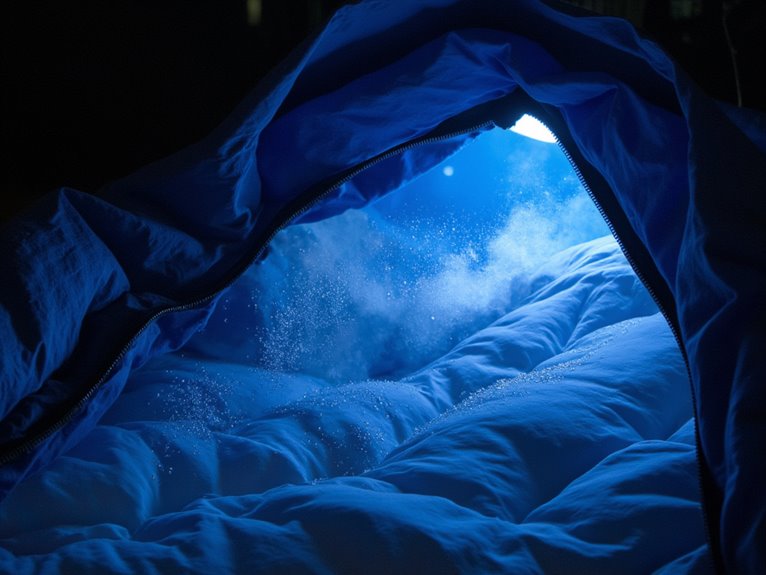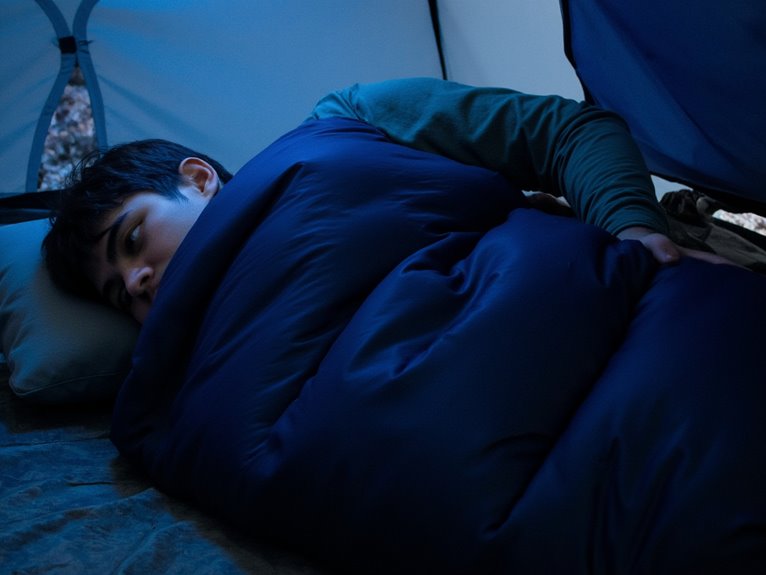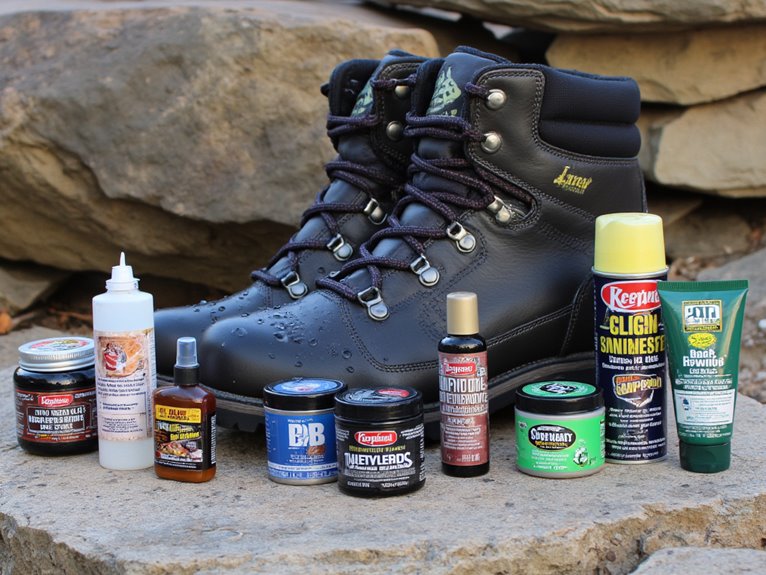Why You’re Not Sleeping Well in Your Sleeping Bag — and How to Fix It
You’re likely misunderstanding your bag’s temperature ratings—comfort ratings indicate restful sleep thresholds, while limit ratings mean survival conditions. Women need bags rated 10-15 degrees warmer than men’s ratings. Ground heat loss through inadequate sleeping pads (you need R-values over 4.0) kills warmth regardless of bag quality. Poor fit creates cold spots, while degraded insulation loses 25-40% effectiveness over time. Proper preparation, ground insulation, and maintenance solve most comfort issues that plague outdoor sleepers.
We are supported by our audience. When you purchase through links on our site, we may earn an affiliate commission, at no extra cost for you. Learn more. Last update on 4th December 2025 / Images from Amazon Product Advertising API.
Notable Insights
- Your sleeping bag’s temperature rating may not match your personal needs—women typically need bags rated 10-15 degrees warmer than men’s ratings.
- Ground heat loss is stealing your warmth—use a sleeping pad with R-value over 4.0 for three-season or 6.0+ for winter camping.
- Poor bag fit creates cold spots and air circulation—choose a size that contours your body without excess room or compression zones.
- Degraded insulation reduces warmth by 25-40%—inspect and maintain your bag regularly, washing down bags every 20-30 uses with specialized cleaner.
- Environmental factors like air pollution, odors, and sudden noises disrupt sleep quality more than gear choices—practice proper campsite selection and bag hygiene.
Misunderstanding Temperature Ratings Is Sabotaging Your Comfort
Most outdoor enthusiasts select sleeping bags based on a single temperature number printed on the label, unknowingly setting themselves up for cold, restless nights.
Temperature rating misconceptions plague even experienced campers who assume the limit rating guarantees comfort. The limit rating actually represents bare survival conditions where hypothermia is avoided but discomfort is expected. This creates widespread sleeping bag myths about performance expectations.
The comfort rating provides the actual temperature threshold for restful sleep. Testing standards use specific user profiles—a “standard woman” for comfort ratings and “average man” for limit ratings.
Sleeping bag comfort ratings are based on a standard woman’s body, while limit ratings use an average man’s profile.
These don’t account for your individual metabolism, sleep position, or clothing choices. Ratings also assume you’re using base layers and proper sleeping pad insulation, factors that dramatically impact real-world thermal performance.
Women typically require bags rated 10-15 degrees warmer than standard men’s ratings due to physiological differences in heat generation and distribution.
Your Insulation Strategy Is Failing You

Your sleeping bag’s insulation won’t work if you’re losing heat to the ground beneath you.
The cold earth pulls warmth from your body faster than your bag can replace it, creating a thermal deficit that leaves you shivering despite expensive gear.
Whether you’re using down or synthetic fill, ground heat loss and insulation performance issues will sabotage your comfort if you don’t address the underlying physics of heat transfer.
Ground contact compresses your sleeping bag’s insulation, creating a thermal sink that makes proper ground insulation crucial to avoiding hypothermia and poor sleep quality.
Ground Heat Loss Prevention
Conduction silently steals up to 50% of your body heat, transferring it directly from your warm body through your sleeping bag and into the cold ground beneath you.
Your sleeping bag’s insulation compresses when you lie on it, eliminating the air pockets that provide warmth.
A high R-value sleeping pad serves as your primary ground insulation barrier.
R-values above 4.0 work for three-season camping, while winter conditions require R-values exceeding 6.0.
Inflatable pads offer superior insulation but risk punctures.
Closed-cell foam pads provide durability and backup protection.
Smart camping site selection reduces heat loss exposure.
Clear snow, wet leaves, and debris before setup.
Layer closed-cell foam beneath inflatable pads for redundancy.
Cover your entire torso-to-feet contact area with insulation.
Insulation Type Performance
Ground insulation won’t save you if your sleeping bag’s fill material can’t handle the conditions you’re facing.
Down insulation offers superior thermal efficiency through high fill power ratings, but loses all warmth when wet. Synthetic insulation maintains performance in moisture but weighs more for equivalent warmth levels. Your compressibility factors matter for backpacking—down packs smaller, while synthetic options like LoftTek offer decent compression with water resistance through siliconized fibers.
Proper moisture management requires matching insulation type to conditions. Choose down for dry environments where weight matters. Select synthetic for humid or rainy conditions where water resistance is critical.
Fill power above 650 delivers better thermal efficiency with less material. Insulation care affects long-term performance—down needs careful drying, while synthetic requires minimal maintenance to preserve loft and warmth retention.
Poor Fit and Design Choices Are Working Against You
Your sleeping bag’s size and shape directly impact how well you’ll sleep through the night.
If you’re 6 feet tall but using a regular 6-foot bag, you’re creating both mobility restrictions and thermal inefficiencies that’ll keep you awake.
The wrong bag shape compounds this problem—a mummy bag forces heat retention at the cost of movement, while a rectangular bag gives you space to toss and turn but makes your body work overtime to heat the extra air volume.
Adding a quality sleeping pad underneath can dramatically improve your sleep comfort, as most ultralight options weigh only 15.9 to 20 ounces while providing crucial insulation with R-values ranging from 4.4 to 7.2.
Size Matters for Warmth
- Compression zones: Tight areas compress fill material by up to 50%, eliminating thermal barriers.
- Excess volume: Oversized bags require 30% more energy to maintain core temperature.
- Air gaps: Poor fit allows cold air circulation inside the bag.
- Loft maintenance: Proper sizing preserves insulation’s full thermal capacity.
- Heat distribution: Correct fit guarantees even warmth across your body.
Shape Affects Heat Retention
Why do some sleeping bags leave you shivering while others keep you warm in identical conditions? The answer lies in thermal engineering.
Mummy bags retain considerably more heat than rectangular designs by reducing internal dead air space. When your bag fits properly, you’ll warm less air volume while maintaining better insulation contact.
Mummy benefits include superior space efficiency—the narrower profile holds insulation closer to your body, minimizing surface area exposed to external cold.
However, overly tight bags compress insulation, creating cold spots that negate thermal advantages. Conversely, bags with excessive internal volume force your body to heat empty space, increasing heat loss.
The ideal shape contours your body without compression or excess room, optimizing thermal resistance while maintaining comfort.
Environmental Factors Are Undermining Your Sleep Quality
While you might focus on choosing the right sleeping bag for comfort, environmental factors in your sleep location often prove more disruptive to quality rest than gear selection. Air pollution reduces sleep efficiency by increasing nighttime disruptions, while environmental noise decreases sleep quality by up to 4.7%.
Environmental factors at your sleep location disrupt quality rest more than choosing the perfect sleeping bag or bedding.
Temperature extremes compromise sleep by approximately 3.2%, disrupting REM and deep sleep phases. Chemical exposure from accumulated pollutants creates sleep disturbances over time. Urbanization impact includes light pollution and increased residential density that fragments sleep cycles.
- Indoor air quality deteriorates from inadequate ventilation and carbon dioxide accumulation
- Sudden sounds trigger awakenings and fragment natural sleep cycles
- Temperature fluctuations prevent proper thermoregulation during rest
- Heavy metal exposures reach neurotoxic levels affecting sleep patterns
- Built environments with poor insulation worsen multiple sleep disruptions
Additionally, persistent odors from uncleaned sleeping bags can create musty smells that further disrupt your ability to achieve restful sleep in outdoor environments.
Your Preparation and Usage Habits Need an Overhaul
Beyond addressing environmental sleep disruptors, most campers unknowingly sabotage their sleep quality through poor preparation and usage habits that reduce sleeping bag performance by 30-50%.
Your sleeping bag storage practices directly impact thermal efficiency. Long-term compression destroys insulation loft, permanently reducing warmth ratings. Store bags loosely in breathable sacks or hang them uncompressed.
Pre sleep preparation determines overnight comfort levels. Wear clean, dry base layers to minimize moisture transfer. Tight clothing restricts circulation and impairs heat retention. Use a sleeping bag liner to add 5-15°F warmth while protecting interior fabrics. Silk liners offer the best weight-to-warmth ratio at just 5 ounces while adding approximately 5°F of thermal performance.
Position your bag on insulated pads to prevent conductive heat loss. Mummy bags require proper sizing—excess interior space reduces thermal efficiency by 20-30%. Close all zippers and drawcords completely to eliminate drafts.
Material Quality and Maintenance Issues Are Costing You Warmth
Most sleeping bag thermal failures stem from degraded materials rather than environmental factors, with insulation deterioration and compromised shell fabrics reducing warmth ratings by 25-40% over a bag’s lifespan.
Your bag’s material durability directly affects its thermal performance. Down insulation compresses permanently when oils from your body contaminate the clusters, reducing loft and warmth. Synthetic fills break down after repeated compression cycles, typically losing effectiveness after 100-150 uses.
The outer shell’s DWR coating degrades with use. Once compromised, moisture penetrates the fabric and reaches the insulation. Wet down loses 90% of its insulating capacity.
DWR coating failure allows moisture penetration that destroys down’s insulating properties, making waterproof shell maintenance critical for warmth retention.
Even well-maintained down bags show decreased loft and clumping after 10-15 years of regular use, with proper care extending effectiveness but fill power ratings inevitably declining over time.
Essential insulation maintenance practices include:
- Washing down bags every 20-30 uses with specialized down cleaner
- Air-drying thoroughly to prevent mold and maintain loft
- Storing uncompressed in breathable cotton storage sacks
- Reapplying DWR treatments annually to shell fabrics
- Inspecting seams and baffles for damage before each trip




